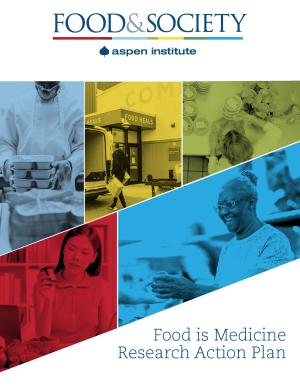Food & Society at the Aspen Institute examined the published, peer-reviewed research on medically tailored meals, medically tailored groceries, and produce prescriptions conducted in the United States through December 1, 2023. They summarized what has been tested and how, for what purposes, and in what populations. The following insights have been adapted for this page.
Medically Tailored Meals: Peer-Reviewed Literature
Medically Tailored Meals (MTMs) are fully prepared meals designed by registered dietitians and nutritionists to address an individual’s medical diagnosis, symptoms, allergies, and medication side effects.
Due to the wide range of program designs and conditions in the MTM research, it’s difficult to compare across studies and make overarching conclusions.
Key Takeaways
- MTMs can reduce health care utilization, and even mortality in specific circumstances, among patients with advanced chronic disease, and most promisingly, among patients with recent heart failure hospitalization.
- More research is needed to better understand which populations might see this reduction in health care utilization and what intensity and duration of MTMs are required.
- Reduced health care utilization is not a guaranteed outcome and will likely be program specific.
- Even among patient populations that do not see immediate reductions in health care utilization, MTMs can result in significant physical and mental health gains and improve the management of diet-related diseases.
Research Needs
- More research is needed to understand optimal intervention intensity (the amount of food provided), impacts of specific dietary plans, or the duration for different health conditions and levels of acuity.
- Research could also evaluate which participants could transition to a less-intensive medically tailored groceries or produce prescription program and maintain health outcomes, on what timeline, and under what circumstances.
- Research could investigate what happens to meal recipients’ diet and health once an intervention ends, and if health benefits are maintained.
- More qualitative analyses could provide important insights into how programs can effectively achieve and enhance participant engagement.
Medically Tailored Groceries: Peer-Reviewed Literature
Medically tailored groceries are distributions of unprepared or lightly processed foods that recipients are meant to prepare for consumption at home; the contents are sufficient to prepare nutritionally complete meals or provide a significant portion of the ingredients for such meals, including produce, whole grains and legumes, and lean proteins.
Key Takeaways
- The medically tailored groceries literature is less established than MTM literature, with fewer randomized trials and quasi-experimental studies with comparison groups.
- Studies have not yet explored the impacts of health care utilization and health care costs.
- Similar to the MTM literature, due to the wide variation in program design and patient population, it’s challenging to compare across studies or make definitive conclusions on efficacy.
- Several studies have shown promising impacts on health outcomes, yet the largest trial to date did not find a significant impact on diabetes management.
- Recent studies have focused on program implementation and learning directly from participants about facilitators and barriers to program engagement.
Research Needs
Future research on medically tailored groceries should investigate intervention design, especially to increase participant engagement to ensure that participants are routinely picking up food or having it consistently delivered.
Similar to the MTM literature, the medically tailored groceries literature has large gaps in knowledge:
- Regarding the ideal program intensity (what percentage of dietary intake is provided
- Scaling the amount of food based on household size
- Addressing participant tastes, preferences, and convenience considerations (location, transportation, physical ability, etc.)
These critical design features are worthy of independent investigation.
- How much food is provided and for how long does it yield optimal results for different health conditions?
- Does allowing for participant choice increase program satisfaction and adherence?
Research also needs to investigate what happens when participants bring food home.
- Do they have the time, knowledge, skills, and tools to prepare meals?
- Who helps them and shares food with them?
- How are foods used to support the needs of others in their community?
- Which foods are participants able to easily incorporate into their cooking?
- What resources are freed up when providing medically tailored groceries, and how does this translate into other gains such as extra disposable income?
Finally, as with medically tailored meals, research needs to explore what happens to participants when the intervention ends and whether health outcomes can be sustained.
Produce Prescriptions: Peer-Reviewed Literature
The definition of “produce” can also vary by program: most programs support access only to fruits and vegetables, while others have included legumes, grains, and more, blurring the distinction between produce prescriptions and medically tailored groceries.
Produce is generally fresh but can also be canned or frozen if there is no added sugar, salt, or fat. The redemption or pick-up site varies by program. An increasing number of commercial food retailers are serving as redemption sites in addition to farmers markets, which are the traditional access points for these programs.
Key Takeaways
- Like the research on medically tailored groceries, the research on produce prescriptions reveals significant differences in intervention design such as:
- Prescription amount
- Program duration
- Program convenience
- These differences make it hard to draw meaningful conclusions about effectiveness.
- Low participation or redemption rates and many pre-post studies without comparison groups compound this challenge.
- Recent studies have shown promising impacts on managing clinical biomarkers for adverse cardiometabolic health, like weight, blood pressure, and blood sugar control.
- To have an impact on clinical outcomes, future trials would likely be more successful by:
- Maximizing participant redemption rates
- Scaling incentives by household size
- Providing sufficiently high monthly value for six months or more
Research Needs
Research must investigate questions such as:
- How to best operationalize produce prescription programs
- How to maximize redemption rates
- What happens when the program ends
Research should:
- Understand the household effects of produce prescriptions
- Investigate which patient populations are most likely to benefit
- Minimum effective duration and intensity of interventions
- Cost effectiveness
- The role of nutrition education
- The potential benefit of produce beyond fruits and vegetables (i.e., whole grains, nuts, seeds, beans, and legumes)
Regardless of the research question, more studies with strong comparison groups will advance the produce prescription field in the years to come.
For the full report and descriptions of the peer-reviewed literature, visit the Aspen Institute website.



